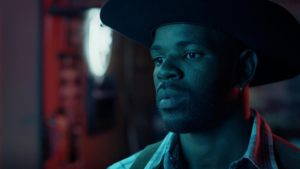1. Capture Every Idea
Since attending Columbia’s film school himself in the early nineties, Schwab has kept a physical and now also a digital story notebook in which he tries to make at least one entry every single day. He says these entries could be “an article, a memory, a line of dialogue I overheard, a story told to me, a dream. Really, anything that attracted me, fascinated me. Anything at all.” He describes the entries as ideas that “rang an internal tuning fork” in his soul telling him why he’s interested in something.
Two of Schwab’s panelists, Tamara Jenkins (The Savages, Slums of Beverly Hills) and Destin Daniel Cretton (Short Term 12, Just Mercy), also have their own versions of the story notebook in the forms of journals, schedules, or files on their phone. Jenkins also employs a strategy she learned from Twyla Tharp, where she keeps boxes around her workspace, each for different projects. When any idea, big or small, crosses her mind, she writes it on a notecard and drops it in the corresponding box.
As Schwab explains, collecting good story ideas is “a craft and one that you could get better at with practice.” Not only that, but by reviewing them periodically, you can identify which ideas still resonate. It is easy to be excited by an idea when you first have it, and if that excitement doesn’t fade when you revisit it, the idea could be worth pursuing. Schwab even keeps an ever-evolving top ten ideas list in his notes. Another benefit of doing this is that when you need to create a new story in a short timeframe, having an “arsenal of ideas” puts you at a great advantage.

2. Identify Your Dramatic Problem
Now that you have an idea for a story, how do you know if it will work? The first question you need to ask yourself is: does it have a character with a “dramatic problem”? This question is the note he gives his students most frequently because the dramatic problems that they create are often, in his words, too vague, too weak, too unfocused, without context, or don’t exist.
But what exactly makes a true dramatic problem? Schwab describes it as “something that causes the audience to worry about the protagonist…A dramatic problem makes me fear for them, for their soul, for their life, for their well-being. It makes me feel that if the problem that’s presented is not resolved in the second act, then this character will suffer physically or emotionally.” These problems can be internal, external, or both, and they often have a “poetic simplicity” to them.
Schwab believes that “every single moment in your screenplay is profoundly intertwined with your character’s dramatic problem, and if you think that drama is about change or the lack of it, the thing that’s being changed is this dramatic problem.” He even identifies the starting point of the script as the character’s dramatic problem and the endpoint as whether it has changed or not.
Between these points is the second act which, “is about the forces, the events, the dialogue, the relationships that force change on the character.” In this light, “if you don’t have a dramatic problem, how do you write anything else? How do you write your second act or inciting incident or your third act? ” Identifying the dramatic problem is “where it all begins”, and it’s the key to writing your screenplay all the way through the third act.
If you don't have a dramatic problem, how do you write anything else?
David Schwab Tweet
3. Tell an Authentic Story
It is one thing to have an idea for a story, but another to be able to tell it compellingly from a place of real authenticity. To do this, Schwab encourages writers to start by looking at the stories that already resonate deeply with them. He advises searching for stories, “that are about what obsesses you, about what you are inspired by, about what you think about, about what disturbs you, about what you love, about the worlds you already know, about the people you already know.”
Schwab warns not to be afraid to get too autobiographical in your writing. He feels that it’s crucial to get past the fear of revealing too much of yourself because “when writers write what they know about, it elevates the writing. It helps them discover their voices. It makes their writing more powerful, more original.”
A particular trap that Schwab cautions about is writing genre pieces. He reflects on a former teacher of his, screenwriter Frank Daniel, who felt that students who create genre stories are “usually trying to protect themselves. They’re believing that the genre formula will help them put together some acceptable plot…and what they usually end up with is something quite empty. They aren’t in their story, and they aren’t in this chosen genre, and what they end up with are cliches, empty plots, flat characters, and dull dialogue.”
Panelist Destin Daniel Cretton believes the mistake he’s learned the most from is writing from a place of insecurity, trying to create what he thinks is going to sell vs. what is meaningful to him. Instead, “it does the opposite. It turns it into something everyone’s seen before”, making the writing feel inauthentic and “cardboardy.” He considers this his own form of writer’s block, and in the same way writer’s block is a part of the typical process you must work through, Cretton usually has to work through this to uncover his voice in the piece.
Finding autobiographical connections to the story you are working on is one effective way to write from a place of authenticity. This, however, does not have to mean only writing about things that happened to you in a literal sense. Panelist Tamara Jenkins describes the jumping-off point for her films as having an “autobiographical spark”, but it morphs as they “take off and become dramatic.” She adds, “the needs of the story start to make you do things that in real life never happened.”
Similarly, Cretton just finished shooting a new Marvel film, Shang-Chi and the Legend of the Ten Rings, which is the first Asian-American superhero film. While its premise is based on comic books, Cretton feels that at its core, it’s surprisingly relatable to his personal story. As a kid, he wished he had a superhero who looked like him, and now he is creating one for the screen.
4. Do Your Research
If you aren’t writing something with any autobiographical link, how can you make it have that same captivating authenticity? Schwab’s answer: research, but far more research than his students usually anticipate. For one of his own projects about the Unabomber Ted Kaczynski, Schwab read Kaczynski’s diaries which were thousands of pages long, along with thousands of his letters, related newspaper articles, and books, and watched video clips of him. Schwab even read some of the books that were found in Kaczynski’s cabin at the time of his arrest. Schwab studied Kaczynski until he felt confident that he knew the character well enough that his imagination could take over.

Mira Nair (Monsoon Wedding, Mississippi Masala), another acclaimed writer/director that Schwab interviews, often pulls from her documentary filmmaking background, using the filmmaking style of cinema verite to capture an intense realism in her pieces. Even in her fictional films, she doesn’t stray far from trying to capture reality. The research process for creating her debut fictional feature Salaam Bombay! consisted of her living with street kids in Bombay and doing what they did for four months. She and her writing partner then wrote the film by combining the real stories of the kids with their own imaginations.
Cretton, who recently wrote and directed Just Mercy, a biographical film about the public interest lawyer and social justice activist Bryan Stevenson, believes that what got him the role was that he had “a healthy dose of just straight fear of f*cking it up”, which prompted him to “obsessively learn” everything that he could about the subject. He “went into it as a student both of Bryan Stevenson and his work, but also just a student to the current and historic plight of black people in America.”
Cretton reflects on how “adapting something from a book and from a life of someone who is still living definitely requires carefully choosing the right subject” because it potentially possesses a unique set of challenges if you misselect. Lastly, Cretton doesn’t believe he would have done the project had he not had complete access to Stevenson himself. Cretton was also able to interview other people connected to the events of the film and visit the actual locations with Stevenson. This mindset and extensive research are essential to give voice to stories that are not your own.
5. Take a Litmus Test
You’ve come up with an idea that has a dramatic problem, and you feel capable of telling it in an authentic, compelling way. Yet, like so many other screenwriters, you still have a nagging doubt… Is this the story you should tell? To alleviate this feeling, which Schwab himself often has before he embarks on his multi-year journey of writing a feature, he does a “litmus test”. Just as you would with your various screenplay drafts, he urges writers, “to put your ideas out in the world.” He does this by writing an email with about six informal paragraphs about the idea to “give it some shape” describing “what its dramatic problem is”, “what the tension of the second act is”, “what the ticking clock is”, and “the kind of obstacles that a character is going to face.” He then sends this email to friends who know about screenplays (his “brain trust”), to help him figure out if it is an idea worth pursuing.
While running ideas past others can be beneficial, it is important to keep in mind that you might be the only one who can truly envision the idea, and others won’t fully understand it until they watch it. For Mira Nair, the people she’s pitching to don’t always know the worlds of her film, so she uses music and pictures to make her idea “feel totally relatable” when she’s describing it to them.
Your litmus test could also be a personal one. It is one thing to believe that the idea is a gripping story to tell; however, it is another to really want to tell it. For Cretton, he forces himself to think “if I died in the middle of the process of making it, is it worth it?” He stresses that he “definitely doesn’t ever look at anything as a stepping stone to something else. I look at it as: what will the personal experience of this be? And I personally believe that if I make a brilliant movie, and it was a shit experience, that it’s not really worth it.”
While it’s not always extremely conscious, Cretton also tries to create his films to fulfill the purpose they served for him as a kid: to make people “feel less alone in the world.” When he saw characters experiencing similar struggles to him, he “realized there’s probably a lot of people going through it if they made a movie about it.” Now, he feels his films are worthwhile when he gets a message “from someone who felt like they identified so deeply to this character, and it made them feel like they weren’t going through it by themselves.”



